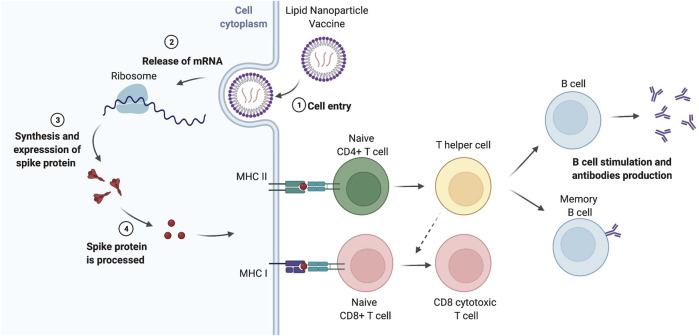FIGURE 1.
Lipid nanoparticle-based vaccines. After intramuscular injection, lipid nanoparticle (LNP) vaccines are recruited by tissue-resident dendritic cells (DCs) or resident-somatic cells (muscle cells), which translate the mRNA into proteins that are processed leading to the generation of peptide epitopes derived from the spike protein of the virus (Rijkers et al., 2021). The antigens are presented on MHC I (in the case of resident-somatic cells) and MHC II (for antigen-presenting cells including DCs) to naïve CD8+ T cells and naïve CD4+ T cells, respectively, which elicit the immune response against SARS-CoV-2. T helper cells differentiated from naïve CD4+ T cells stimulate the proliferation and differentiation of B cells in memory B cells and plasma cells, the latter secreting antibodies against the spike protein. On the other hand, naïve CD8+ T cells, with the assistance of T helper cells, produce CD8 cytotoxic T cells, responsible for the killing of the infected cells. Memory T cells (not shown) are also generated, and they are also important for the long-term protection against infection. It is worth remarking some LNPs can drain to the closest lymph nodes and interact, directly, with the resident immune cells and activate the T and B cells. Moreover, muscle cells in the injection site can also internalize the LNPs, process the mRNA and express the specific antigens on MHC class I, participating in the CD8+ T cell activation (Hou et al., 2021). The figure was prepared using BioRender.

